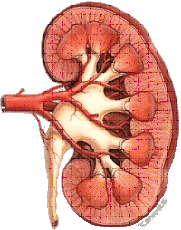Automated Wearable Artificial Kidney (AWAK) - Progress Update
Martin Roberts, PhD, UCLA and VA Health System Los Angeles

Wednesday, February 25, 2009 7 PM
CLU - Richter Hall, Ahmanson Science Building
Unlike the natural kidney, available artificial kidneys (hemodialysis, HD, and peritoneal dialysis, PD) for the treatment of end-stage renal disease (ESRD) patients do not provide optimum and round-the-clock toxin removal and metabolic and fluid regulation; do not remove protein-bound toxins; and impose regimentations which compromise normal living activities. In addition to chronic ill-health, ESRD patients treated with dialysis have a high death-rate.
A wearable artificial kidney can duplicate the natural kidney by providing round-the-clock function. Available work on wearable kidney has focused exclusively on the technology of HD/hemofiltration, which requires blood to circulate outside the body (extracoporeal circulation) and to come into contact with artificial membrane for purification. To-date, HD/HF-based wearable kidney has uniformly failed to function for extended period because of blood-clotting not amenable to anticoagulation therapy. A need for extensive monitoring of the extracoporeal circulation and potential immunologic and non-immunologic complications of life-long blood-artificial membrane interactions are some of the other concerns.
We have worked on a peritoneal dialysis-based automated wearable artificial kidney (AWAK). PD does not require an extracoporeal circulation and is therefore “bloodless”. It is also “waterless” because the spent dialysate, instead of being discarded (as is in current practice), is continuously regenerated and reused in perpetuity. A sorbent-based assembly regenerates both the aqueous and the protein components of the spent peritoneal dialysate, producing a novel autologous protein-containing dialysate that can remove both the water-soluble and protein-bound toxins. Automated dialysis-on-the-go frees the ESRD patients from the servitude of current dialytic regimentations.
Martin Roberts, PhD.
Consultant in Nephrology, VA Greater Los Angeles Healthcare System and Assistant Professor of Medicine, David Geffen School of Medicine at UCLA
 Dr. Roberts and his collaborator, David BN Lee M.D., have worked in the field of dialysis and the wearable kidney for decades. Dr. Roberts received his PhD from USC and M.A. from Brooklyn College. Holder of six patents and the recipient of the 2001 Distinguished Honoree for Outstanding Contributions to Nephrology in the Area of Research from the American Nephrology Nurses Association, Dr. Roberts has been associated with Nephrology for over 40 years, most of that time in Southern California. He is assistant professor of clinical medicine at the David Geffen School of Medicine at UCLA and a dialysis consultant with the VA Healthcare System. Dr. Roberts and his collaborator, David BN Lee M.D., have worked in the field of dialysis and the wearable kidney for decades. Dr. Roberts received his PhD from USC and M.A. from Brooklyn College. Holder of six patents and the recipient of the 2001 Distinguished Honoree for Outstanding Contributions to Nephrology in the Area of Research from the American Nephrology Nurses Association, Dr. Roberts has been associated with Nephrology for over 40 years, most of that time in Southern California. He is assistant professor of clinical medicine at the David Geffen School of Medicine at UCLA and a dialysis consultant with the VA Healthcare System.
|


 Dr. Roberts and his collaborator, David BN Lee M.D., have worked in the field of dialysis and the wearable kidney for decades. Dr. Roberts received his PhD from USC and M.A. from Brooklyn College. Holder of six patents and the recipient of the 2001 Distinguished Honoree for Outstanding Contributions to Nephrology in the Area of Research from the American Nephrology Nurses Association, Dr. Roberts has been associated with Nephrology for over 40 years, most of that time in Southern California. He is assistant professor of clinical medicine at the David Geffen School of Medicine at UCLA and a dialysis consultant with the VA Healthcare System.
Dr. Roberts and his collaborator, David BN Lee M.D., have worked in the field of dialysis and the wearable kidney for decades. Dr. Roberts received his PhD from USC and M.A. from Brooklyn College. Holder of six patents and the recipient of the 2001 Distinguished Honoree for Outstanding Contributions to Nephrology in the Area of Research from the American Nephrology Nurses Association, Dr. Roberts has been associated with Nephrology for over 40 years, most of that time in Southern California. He is assistant professor of clinical medicine at the David Geffen School of Medicine at UCLA and a dialysis consultant with the VA Healthcare System.